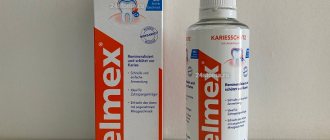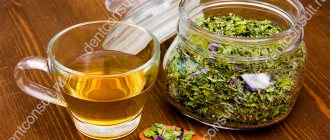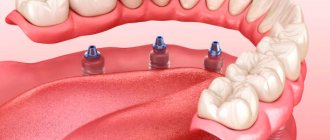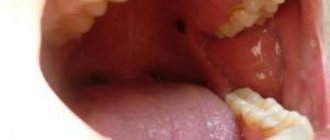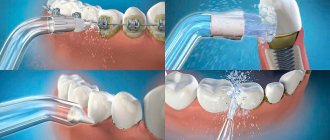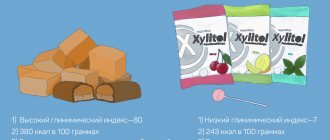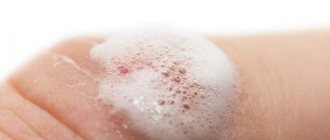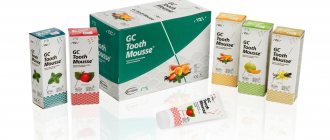From this article you will learn:
- how to choose a rinse for teeth and gums,
- rating of mouthwashes 2021.
- reviews of Listerine, Elmex, Forest Balsam, etc.
The article was written by a dentist with more than 19 years of experience.
Mouth rinses are excellent means of caring for teeth and gums, but they can only be considered as additional care, and their use cannot replace mechanical brushing of teeth (using a toothbrush and toothpaste). They are especially recommended for patients who do not use dental floss to regularly clean interdental spaces and do not brush their teeth after every meal. In children, rinses can be used from 6-7 years of age.
Modern mouthwashes, as a rule, no longer contain alcohol (as a solvent and preservative), and components such as sodium lauryl sulfate and parabens. However, mouth rinses cannot be called a completely safe product – when it comes to their long-term use. And in this article we will talk not only about the criteria for choosing the best mouthwash, but also how they affect the mucous membrane and microflora of the oral cavity.
The article’s author’s favorite mouthwash is
Most types of mouth rinses are designed to strengthen teeth and protect them from caries. Other products may be intended to treat or prevent inflammation of the gums, to reduce tooth sensitivity, for halitosis (bad breath), and to reduce symptoms of xerostomia (dry mouth). A large group of rinses has a combined composition that can allow you to simultaneously act on several problems in the oral cavity.
Children can use mouthwash from 6-7 years of age. This is due to the fact that in young children the swallowing reflex is not yet fully controlled, and therefore involuntary swallowing of the mouthwash is possible. Which is not very safe.
How to choose the right mouthwash -
This article was written by a dentist, and its main goal is to teach you how to navigate the compositions of mouth rinses from different manufacturers so that you can choose the most optimal product for you. Below you will find a rating of the best rinses for teeth and gums for 2021 (+ recommendations for their use).
First, we will talk about how to choose the best rinse for dental caries, and then we will move on to other products that can be used for gum inflammation, to relieve hypersensitivity, or to whiten teeth.
1) Protection against caries (with fluoride and xylitol) –
Fluoride rinses can provide the strongest protection against caries. Components such as sodium fluoride or amino fluoride (in concentrations from 230 to 450 ppm, but on average 250 ppm) can be used as fluorides. The mechanism of anti-caries protection of fluoride-containing products is very interesting. The fact is that fluoride ions bind to the crystals of “hydroxyapatite”, which makes up the enamel of teeth, turning them into “fluorine-hydroxyapatite”.
You probably know that cariogenic bacteria convert food debris into acids, which lead to the dissolution of hydroxyapatite in tooth enamel and, accordingly, to the formation of a carious defect. Tooth enamel usually begins to dissolve at an acidity pH of 5.5 or lower. But if the surface layer of enamel contains fluoride, then tooth decay begins only at a lower pH value of 4.5 (i.e., at a much higher acid concentration!).
Sodium fluoride and amino fluoride (synonym - olaflur) are the best fluoride compounds, and amino fluoride is the most effective. You can rinse your mouth with amino fluoride for only 30-45 seconds, while with sodium fluoride - for 45-60 seconds. This is due to the fact that in the oral cavity aminofluoride dissociates more quickly with the release of active fluoride ions than sodium fluoride and, even more so, than monofluorophosphate (the latter is effective if you rinse your mouth with it for at least 1.5-2 minutes).
Important: but not only fluoride can provide anticaries effect. Additional anti-caries protection can be provided by xylitol (synonym - xylitol), which can also be included in mouthwashes from some manufacturers. Xylitol effectively inhibits the growth of carious bacteria and reduces acidity in the oral cavity, however, the anti-carious effect of xylitol is significantly inferior to that of fluorides.
2) Anti-caries rinses (without fluoride) –
Some anti-caries rinses may not contain fluoride, and a combination of “calcium compound + xylitol” may be used instead. As calcium compounds, the ROCS company uses a combination of “calcium lactate and calcium glycerophosphate,” and the SPLAT company uses a combination of “calcium lactate + ultrafine hydroxyapatite.” In addition, ROCS rinses contain a high concentration of xylitol.
When compared with the anti-caries effectiveness of fluoride rinses, these products will certainly be less effective in preventing dental caries. In addition, such products are more effective only after brushing your teeth, and not in the middle of the working day after eating. The fact is that within 1-2 hours after brushing your teeth, a biofilm consisting of oral bacteria, as well as proteins and carbohydrates, forms on them. Such a biofilm will prevent the penetration of calcium ions into tooth enamel.
In turn, fluoride ions have a higher penetrating ability through the biofilm, and in addition, they themselves have an antibacterial effect, inhibiting the growth of microbial plaque. In addition, there is another important point that depreciates mouth rinses with calcium (without fluoride).
Important: if you use rinses immediately after brushing your teeth in the morning and evening, then it makes no sense to use a rinse with calcium after brushing your teeth with fluoride paste (there is a rule “first calcium - then fluoride”). In this case, you would have to first brush your teeth with a calcium-free, fluoride-free toothpaste, and then use a calcium-free, fluoride-free mouthwash. But this also makes no sense.
It would be logical to first brush your teeth with a paste containing calcium compounds (without fluoride), and immediately after that, rinse your mouth for 40-60 seconds with a fluoride rinse. In this case, calcium ions first penetrate into the tooth enamel and are then sealed there with fluoride ions, and this combination is the most effective protection against caries. If you use a mouthwash after lunch in the middle of the working day (instead of dental floss), it is better to again use a mouthwash with fluoride (+ xylitol).
Criteria for choosing a rinse aid
It is necessary to choose a rinse aid carefully - this will help to avoid various misunderstandings in the future. That is why it is recommended that you first make an appointment for a consultation with your doctor to clarify your individual characteristics, because This or that solution is not suitable for everyone. In addition, in order to avoid purchasing a low-quality product, you should ask for the product only in trusted pharmacies.
Of course, daily use of mouthwash can protect you from many problems with teeth and gums. However, we should not forget that the choice of remedy is a rather personal issue that should be resolved with the help of a dentist. Often, an incorrectly selected solution can only aggravate existing diseases or cause banal irritation.
When buying a rinse liquid, you need to look, first of all, at the spectrum of its effects. So, to prevent caries, you should take a product with amino fluoride or sodium fluoride. Antiseptic rinses with a high content of chlorhexidine, triclosan and other substances should not be used for longer than 2-3 weeks. Otherwise, this will lead to disruption of the microflora in the mouth, as a result of which the mucous membrane may dry out and an odor may appear.
For those who have obvious gum problems and chronic gingivitis, liquids with herbal extracts and plant components are perfect. They can be used for quite a long time to achieve maximum effect. Often these are the solutions prescribed by periodontists during the treatment of gum inflammation.
Mouthwashes for caries prevention –
The best fluoride compound in mouthwashes is aminofluoride (synonym: olaflur), and in second place is sodium fluoride. These compounds have the highest anti-caries effectiveness, but it is necessary to take into account not only the type of fluoride compound, but also its concentration. In addition, you will not see antiseptics, antibiotics or alcohol in the anti-caries rinses we have chosen, which means that their use on an ongoing basis will not cause harm to your health.
1) ELMEX “Protection against caries” mouthwash
manufacturer: Germany/Poland,- active ingredients – aminofluoride (olaflur) + sodium fluoride,
- fluorine content – 250 ppm,
- does not contain alcohol,
- price: 400 ml – from 250 to 350 rubles.
Comments: ELMEX series toothpastes and rinses are a professional line of oral hygiene products from Colgate®, which belongs to the pharmacy range. The products in this series contain more expensive and high-quality active ingredients (and higher concentrations) - compared to other products of this company. In our opinion, the Elmex “Protection against Caries” rinse is one of the best mouth rinses for the prevention of caries, which can be used in adults and children from 6 years of age.
Usage regimen: 2 times a day, morning and evening (breakfast/dinner → brushed teeth → rinsed mouth). It is especially good if, before using the mouthwash, you brushed your teeth with a toothpaste based on a combination of calcium compounds (without fluoride), for example, calcium lactate, calcium pantothenate, calcium glycerophosphate and hydroxyapatite. As we said above, this strategy of using calcium/fluoride provides the highest anti-caries protection.
Or you can use it once a day in the middle of the working day (for example, immediately after lunch). But in this case, it will be even better if you also use dental floss to clean the interdental spaces before the rinse. Rinse time – 30-45 seconds. For rinsing the mouth, 10 ml of the drug is enough. After spitting the solution, do not rinse your mouth with water under any circumstances (the effectiveness will be higher).
2) Rinse aid PRESIDENT PROFI Classic “For daily care”
manufacturer: Italy,- active ingredients – sodium fluoride + xylitol, as well as extracts of sage, lemon balm and chamomile,
- total fluoride content – 450 ppm,
- does not contain alcohol,
- price for 250 ml – from 250 rubles.
Comments: PRESIDENT PROFI Classic Series Mouthwash “For Daily Care” - contains the highest dosages of sodium fluoride and xylitol (xylitol) available on the market. Thus, the product has a very powerful anti-caries effect, and also contains anti-inflammatory extracts of medicinal plants. This mouthwash is as good as the ELMEX Anti-Caries Mouthwash, and in some aspects it is even better.
The only difference between PRESIDENT PROFI Classic is that it will require a slightly longer rinse (about 40-60 seconds), instead of 30-45 seconds for Elmex. If you take a mouthwash to use after lunch in the middle of the day, we would even put PRESIDENT PROFI Classic in 1st place (since the presence of xylitol will also reduce acidity in the oral cavity). And do not forget that in this case, before using the mouthwash, it is advisable to use dental floss to clean the interdental spaces from food debris.
Clinical researches
The effectiveness of Asept products has been clinically proven. For example, multiple clinical studies have proven that the two-component mouth rinse ASEPTA ACTIVE more effectively fights the causes of inflammation and bleeding compared to single-component rinses - it reduces inflammation by 41% and reduces bleeding gums by 43%.
Sources:
- The role of anti-inflammatory rinse in the treatment of periodontal diseases (L.Yu. Orekhova, A.A. Leontyev, S.B. Ulitovsky) L.Yu. OREKHOVA, Doctor of Medical Sciences, Prof., Head of Department; A.A. LEONTIEV, dentist; S.B. ULITOVSKY, Doctor of Medical Sciences, Prof. Department of Therapeutic Dentistry of St. Petersburg State Medical University named after. acad. I. P. Pavlova
- Report on clinical trials to determine/confirm the preventive properties of commercially produced personal oral hygiene products: mouth rinse "ASEPTA PARODONTAL" - Solution for irrigator." Doctor of Medical Sciences Professor, Honored Doctor of the Russian Federation, Head. Department of Preventive Dentistry S.B. Ulitovsky, doctor-researcher A.A. Leontiev First St. Petersburg State Medical University named after academician I.P. Pavlova, Department of Preventive Dentistry.
- Report on determining/confirming the preventive properties of commercially produced personal oral hygiene products: Asepta toothpaste used in combination with Asepta mouthwash and Asepta gum balm Head. Department of PFS Doctor of Medical Sciences Professor S.B. Ulitovsky St. Petersburg State Medical University named after Academician I.P. Pavlova. Faculty of Dentistry. Department of Preventive Dentistry.
Mouthwashes for sensitive teeth –
Mouthwashes to reduce tooth sensitivity may contain 2 types of active ingredients.
Firstly, these are fluorides, which include sodium fluoride, amino fluoride (olaflur) and potassium fluoride. These components work by creating a layer of calcium fluoride on the surface of the enamel, which protects teeth from the influence of chemical, thermal and mechanical irritants. However, the effect of using this group of components develops gradually. The second group of substances includes potassium compounds - such as potassium nitrate and potassium fluoride, which work by reducing the sensitivity of nerve endings in dental tissues. This group of substances acts more quickly, but the effect will disappear immediately after using the product. Therefore, ideally, rinses contain a combination of active substances: both fluorides and potassium compounds.
Rinse aid ELMEX “Sensitive Plus” –
manufacturer – Germany,- active substances are aminofluoride, potassium fluoride, as well as “dimethyl-amino-ethyl methacrylate-polycarbamyl-polyglycol”.
- fluoride content – 250 ppm,
- price for 400 ml – from 260 rubles.
Comments: in our opinion, Elmex Sensitive Plus is one of the best rinses for reducing dental hypersensitivity. It contains amino fluoride, the substance potassium fluoride (which, upon dissociation, decomposes to form active fluoride ions and potassium ions), as well as a special polymer “dimethyl-amino-ethyl methacrylate-polycarbamyl-polyglycol”, which creates a protective biofilm on the surface of the tooth. Ideally, combine this product with Lacalut Extra Sensitive toothpaste.
Rinse aid PRESIDENT “Sensitive Plus” –
manufacturer – Italy,- active ingredients – potassium nitrate, calcium lactate, xylitol, as well as linden and chamomile extracts,
- fluoride content – without fluorine,
- price for 300 ml – from 220 rubles.
Comments: PresiDent Sensitive Plus rinse contains a very high dosage of potassium nitrate, which ensures rapid reduction of hypersensitivity. In addition, the product contains calcium lactate to increase the mineralization of tooth enamel, as well as a high concentration of xylitol (it neutralizes acid in the oral cavity, thereby inhibiting the demineralization of teeth, and ultimately also indirectly helps reduce hypersensitivity.
Important: We would like to point out that mouthwashes to reduce dental hypersensitivity are only a secondary treatment for this problem.
They do not allow achieving a greater effect than can be achieved with special toothpastes and concentrated gels used for increased tooth sensitivity. Such rinses are a good option for use in the middle of the working day, and in the morning and evening it is better to use toothpaste for these purposes.
Composition of funds
The composition may include the following main components:
- Substances aimed at eliminating the risk of inflammation (antiseptics). These include: triclosan, chlorhexidine
- Fluorine compounds (sodium fluoride, etc.)
- Extracts from plants (extracts)
- Xylitol
- Ethanol
The components contained in each product may differ depending on the purpose for which a particular mouthwash is made. Ethyl alcohol is practically not used in modern rinses, since it can dry out the oral cavity.
Features of the use of rinses -
Typically, mouth rinse is used 2 times a day (morning and evening - immediately after meals and subsequent brushing of teeth). The second option is that you can use the mouthwash immediately after lunch in the middle of the working day, but in this case, before rinsing, it is advisable to clean the interdental spaces from food debris using dental floss. We have listed the basic rules below.
Scheme for using mouth rinses -
- For rinsing, 10 ml of solution is enough (15-20 ml may be written on the rinse aid packaging, but this is only for the purpose of making you buy a new package faster),
- rinsing time averages from 45 to 60 seconds (the exact time depends on the type of rinse aid, and will be written on the product packaging; some types of rinses without alcohol and antiseptics, for example, Parodontotsid, 2-3 minutes are recommended),
- after spitting the solution, you should not rinse your mouth with water, eat for several hours, or drink for at least 30 minutes (this is a desirable rule that will increase the effectiveness of the procedure, but not mandatory),
- do not use rinses with alcohol, as well as products with antiseptics or antibiotics - more than 10-14 days (in this case you will get side effects).
Sore gums: will mouthwash help?
To combat gum inflammation, rinses are often used as a simple and affordable remedy. However, it is necessary to understand that the solution can only temporarily remove symptoms, but not eradicate the cause of inflammation, therefore, after stopping its use, inflammation will return.
The main cause of bleeding gums is soft microbial plaque and subgingival deposits, which need to be eliminated by visiting a dentist. After the procedure, he will prescribe medications as part of anti-inflammatory therapy. Using a mouthwash without treatment will mask the symptoms of inflammation, but the inflammatory process will not stop: as a result, sooner or later the teeth will begin to become loose.
Mouthwashes - side effects
Mouth rinses contain only surfactants that cannot penetrate the oral mucosa and enter the bloodstream unless, of course, you swallow them. But nevertheless, mouth rinses are not as safe as they might seem, and the maximum negative effect develops with prolonged use.
What you need to pay attention to. Firstly, it is better to avoid products containing alcohol, because... with prolonged use, this leads to thinning and dryness of the oral mucosa. The second point is that if you have allergic manifestations on the mucous membrane of the oral cavity, then it is better to avoid rinses with parabens (for example, preservatives such as methylparaben or ethylparaben). Parabens cause oral allergies in approximately 4% of people.
If you periodically experience stomatitis (aphthous or herpetic), we recommend avoiding rinses with sodium lauryl sulfate. By itself, this component cannot cause stomatitis, but it leads to accelerated desquamation (squamation) of the epithelium of the oral mucosa, which makes the mucosa thinner and more vulnerable. It has been noticed that when using oral hygiene products with lauryl sulfate, outbreaks of stomatitis occur more often, and ulcerations of the mucous membrane take a longer time to heal.
Side effects of rinses with Chlorhexidine -
But most of the side effects are associated with long-term use of Chlorhexidine, which is included in almost every rinse for gum inflammation or bad breath. Reputable clinical studies (source) have revealed that within 7 days from the start of rinsing the mouth with chlorhexidine, global changes occur in the microflora of the mouth. Positive changes relate to the fact that chlorhexidine suppresses pathogenic bacteria that cause gum inflammation and bad breath.
But there are also negative aspects. A course of rinsing the mouth with chlorhexidine (reducing the number of some types of bacteria) simultaneously led to an increase in the number of other types of bacteria. Changing the ratio of different types of bacteria in the oral cavity has its consequences. For example, as a result of this, there was an increase in the content of lactic acid in the oral fluid (saliva), which led to a decrease in the buffer capacity of saliva and its ability to neutralize the acid produced by cariogenic bacteria in the oral cavity. Research clearly showed that chlorhexidine rinses led to a decrease in the pH of the oral fluid (i.e., its acidity increased).
And this is very important, because... a decrease in the pH of the oral fluid triggers the process of demineralization of tooth enamel, which significantly increases the risk of developing dental caries. Above we told you about the PRESIDENT Antibacterial rinse “Powerful protection against bacteria”, which contains 0.2% chlorhexidine - in combination with xylitol (xylitol). In this case, xylitol neutralizes the negative effects of chlorhexidine, because it has the property of reducing the acidity of oral fluid. This is also why we consider this mouthwash one of the best for treating gum inflammation.
Important: but that’s not all! Research has shown that chlorhexidine interferes with the ability of oral bacteria to convert nitrates (found in foods) into nitrites. This bacterial activity is called “nitrate-reducing” and is important for maintaining normal blood pressure. The fact is that nitrites help lower blood pressure, and accordingly, a decrease in the production of nitrites by oral bacteria leads to an increase in blood pressure.
This issue is important primarily for patients with chronic cardiovascular pathology. The above points are confirmed by the scientific study “The increase in plasma nitrite after a dietary nitrate load is markedly attenuated by an antibacterial mouthwash. Nitric Oxide" (2008), authors – Mirco Govoni, Emmelie Å. Jansson, Eddie Weitzberg, Jon O. Lundberg. If you wish, you can read this study using the link above using a browser translator.
Differences between natural and synthetic fluoride
The natural form of fluoride is not the same as the synthetic industrial version (sodium fluoride). Fluoride that occurs naturally is known as calcium fluoride. This natural mineral occurs in nature in the form of fluorite mainly in the earth's crust and groundwater at low levels.
The synthetic version of fluoride is called sodium fluoride, which is a byproduct of the phosphate industry. When referring to this synthetic industrial option, the term "fluoride" is used to refer to the many different chemicals that make up fluoride, including but not limited to: lead, aluminum, cadmium, arsenic, hydrofluorosilicic acid, and even radioactive materials. During Nazi Germany, sodium fluoride was given to prisoners in concentration camps because Nazi doctors discovered that its components had a lobotomizing effect on prisoners, making them docile and easier to control. Have you ever heard that many experts link sodium fluoride to lower IQ and increased cancer? Could this toxin actually be one of the root causes of these problems?
Teeth whitening rinses –
This is the last group of funds that we would like to talk about. The fact is that such rinses may contain not only completely harmless, but also quite dangerous components. For example, common “whitening components” include: 1) the enzymes bromelain and papain, which dissolve the protein matrix of plaque, 2) polyphosphates prevent plaque from adhering to the teeth - sodium hexametaphosphate and trisodium phosphate, 3) pyrophosphates and polydone prevent the mineralization of plaque, t .e. its transformation into tartar.
All these components are also found in toothpastes (in certain combinations). But what should never be in rinses is carbamide peroxide/hydrogen peroxide. For example, some ROCS rinses contain “hydrogen peroxide 1.0%” (hydrogen peroxide) to implement the oxygen bleaching mechanism. These components are widely used in professional products - in special whitening trays with gel, whitening strips, etc. But an important condition for use is that the gums are isolated from contact with the gel containing peroxide.
There is a clinical study (“The myth of oral hygiene using synthetic mouthwash products,” 2021). It clearly shows that even small concentrations of peroxides in mouth rinses can lead to mutations in the DNA of cells in the oral mucosa. Those. in this case, we are talking about the fact that such rinses increase the risk of developing cancer, and this risk will be highest in smokers. We hope that our review of mouthwashes was useful to you!
Sources:
1. Dental education of the author of the article, 2. National Library of Medicine (USA), 3. PubMed.gov scientific research database, 4. Official websites of manufacturers of oral hygiene products.
Precautions for use
Before purchasing the product, you should consult with your doctor, since, in addition to the obvious benefits, there are several negative factors associated with its use:
- Change in taste sensations.
- Darkening or change in the natural color of tooth enamel as a result of prolonged use of mouthwash.
- If the product contains ethanol (ethyl alcohol), its use is hazardous to health (since there is a possibility of accidental ingestion of the liquid).
Do not forget about the individual intolerance of the body to some components. It is recommended to carefully study the composition before using the product so as not to cause harm to health. The most common side effects when using mouthwash:
- Burning in the mouth.
- Nausea.
- Diarrhea.
- Dry mouth.
- The appearance of seizures.
- Blueness of fingertips.
- The appearance of an inflammatory process in the lymph nodes.
- Dizziness.
- Blue lips.
- Excessive thirst.
- Impaired coordination of movements.
- Difficulty breathing, etc.
If at least one of the above symptoms appears, you should stop using the drug and consult your doctor. If the product is used as prescribed by a doctor, the risk of side effects is minimal.
Organ damage caused by fluoride
If sodium fluoride is consumed daily, the body becomes contaminated with this synthetic toxin, which can lead to various types of health problems including, but not limited to, heart disease and pineal gland calcification. The brain is very sensitive to sodium fluoride, especially the pineal gland, located in the quadrigeminal region of the midbrain. It is responsible for the production of melatonin, serotonin, adrenoglomerulotropin, dimethyltryptamine.
When the brain and pineal gland are saturated with too much sodium fluoride, they cannot function properly. Typical symptoms of fluoride toxicity include dental fluorosis, chronic fatigue, decreased IQ, headaches, memory loss, blurred vision, hearing loss, sleep disturbance, pineal gland calcification, and neurological problems. These health problems lead to a lack of holistic thinking, creativity, and critical thinking skills. Fluoride leads to premature aging, the appearance of wrinkles, and poor condition of hair and nails. Articular cartilage wears down faster, increasing the risk of arthritis. Fluoride promotes calcium retention in bone tissue, resulting in increased bone density. But due to a high degree of calcification, bones become more fragile, and when hit or fallen, they are more susceptible to fractures. Despite the increase in bone mass, the risk of fracture is high. Fluoride causes significant damage to the mucous membrane of the stomach and intestines, as well as the walls of arteries, veins, and the blood-brain barrier. As a result, calcification of the walls of blood vessels may occur, which subsequently leads to atherosclerosis, etc.
The best rinses for complex therapy of periodontal diseases
Lacalut active
Rating: 4.9
An indispensable remedy for inflammation of various types, good prevention of caries and periodontal disease. It makes an excellent addition to toothpaste from the same company. Among the components there is aluminum lactate, with astringent properties. This helps to fight bleeding and heal small wounds on the mucous membrane.
In addition, there are fluorides that can protect against the most common dental disease - caries. And antibacterial components will make the fight against periodontitis more effective. Reviews also speak about the ability of the product to destroy plaque. And for those who have recently removed tartar, Lacalut active will serve as an excellent prevention against its reappearance. The components of the mouthwash perfectly fight the proliferation of harmful bacteria, protecting the oral cavity from periodontitis, gingivitis and stomatitis.
Advantages
- fights inflammation;
- removes plaque;
- prevention of caries.
Flaws
- Contains chlorhexidine.
ROCS Grapefruit
Rating: 4.8
ROCS Grapefruit takes a worthy place in the ranking. The manufacturing company took care of the safety of the rinse aid, using only natural ingredients. And therefore, over time, a small sediment may appear here, which is easy to get rid of by shaking the bottle.
The product gives long-lasting freshness and has a pleasant aftertaste. The composition does not contain mint, but according to some reviews, it can be felt here. ROCS with grapefruit eliminates bleeding, makes enamel strong and serves as an excellent preventive measure against caries. Moreover, there are no fluoride substances in the composition. This effect is provided by xylitol and kelp extracts. It is worth considering that due to its natural composition, the product can only be stored for a month after opening. Therefore, reviews recommend purchasing this mouthwash for a family of several people.
Advantages
- natural composition;
- fights bleeding;
- caries prevention is ensured.
Flaws
- according to some reviews, the taste of grapefruit is not too pronounced;
- Once opened, it can be stored for a month.
Listerine
Rating: 4.8
This rinse contains essential oils that help get rid of many dental problems. As a result, teeth become stronger, enamel destruction is prevented, and blood supply to the gums improves.
Among the components, the manufacturer also declares fluorides, but in permissible concentrations. They help strengthen tooth enamel, preventing the development of periodontal disease and caries. The rinse aid destroys all harmful bacteria. Reviews note that after constant use, the condition of the gums and teeth improves. Bad breath is eliminated and inflammatory processes stop.
Advantages
- essential oils included;
- prevents enamel thinning;
- The condition of teeth and gums improves with constant use.
Flaws
- Some reviews talk about the strong astringent effect of the rinse aid.
Parodontax Classic
Rating: 4.7
The next place in the ranking is occupied by Parodontax Classic mouthwash. Pleasant to the taste, it perfectly fights inflammation on the gums, reducing bleeding. And thanks to the presence of chlorhexidine in the composition, the product destroys bacteria that cause bad odor.
With regular use, the solution can destroy tartar. In addition, Parodontax Classic retains freshness for a long time; it is enough to use it up to two times a day. Reviews about taking the drug are mostly positive. The composition contains fluoride in acceptable concentrations, which contributes to excellent caries prevention.
Advantages
- has good components;
- reduces inflammation;
- defeats the raid and prevents the emergence of a new one.
Flaws
- the composition includes chlorhexidine;
- does not cure, serves only as prevention.
Asepta Fresh
Rating: 4.7
And this rinse is recommended by many periodontists after removing tartar from the enamel. Teeth become less sensitive, inflammation and bleeding disappear. After using Asept Fresh leaves a pleasant feeling and freshness. At the same time, its taste is not too strong, it will appeal to those who do not like too minty notes.
Users appreciated the natural ingredients. There are no dyes or antiseptics in the composition. Antibacterial effects are provided by extracts of chamomile, witch hazel, and sage, and xylitol fights caries.
Advantages
- contains plant extracts;
- reduces dental plaque;
- fights bleeding gums;
- gives freshness.
Flaws
- uneconomical.
GLISTER from Amway
Rating: 4.6
The next place in the ranking is taken by the mouthwash from Amway. It contains the innovative component proloxamer-407, which helps to gently and effectively remove plaque of any hardness. In addition, the product has antimicrobial and anti-inflammatory effects. It is able to heal any damage to the mucosa.
The rinse aid perfectly combats unpleasant odors caused by pathogens. The composition includes ethanol 24% and a powerful antiseptic Cetylpyridinium chloride. At first glance, the product may seem aggressive, but it is not. Among the components there is a softener - glycerin. Therefore, using GLISTER will not cause any discomfort.
Advantages
- works well against plaque of any complexity;
- restores damaged mucous membranes;
- prevents the proliferation of pathogenic microorganisms;
- resists pathological processes in the gums.
Flaws
- Contains ethanol, the drug is contraindicated in children under 12 years of age.
PRESIDENT Profi
Rating: 4.5
This drug was created to treat gum disease. According to reviews, regular use reduces inflammation, soothes and gives freshness. In addition, tooth enamel is strengthened. Some users note improvement after the first use.
This effect is due to the composition of the drug. Most of it consists of natural ingredients. Sage and chamomile extracts have not only an anti-inflammatory, but also an astringent effect. But for greater effectiveness, PRESIDENT Profi contains chlorhexidine, a powerful antiseptic. It is he who helps in the fight against inflammation. A big plus is the absence of fluorine and alcohol in the composition. The drug is effective, but gentle.
Advantages
- has an anti-inflammatory effect;
- strengthens gums and enamel;
- contains herbal extracts.
Flaws
- not for frequent use.
Oral-B Lasting Freshness Arctic Mint
Rating: 4.5
The next drug in the ranking is a German-made drug. On the plus side, users note a feeling of freshness after use for several hours. It may last until the next rinse. Oral-B Lasting Freshness Arctic Mint provides excellent protection against oral pathogens. According to reviews, it treats any inflammation excellently. In addition, it is a good prevention against caries. If after regular cleaning there are still food particles, the rinse aid will get rid of them.
The whole secret is in the main ingredient of the product. Alcohol accounts for 11.5%. This helps keep the oral cavity clean and heals small cracks. But this is precisely the main drawback. According to reviews, the product is too aggressive.
Advantages
- fights harmful microorganisms;
- relieves inflammation;
- soothes irritated mucous membranes;
- prevention of caries;
- creates a feeling of freshness.
Flaws
- creates a burning sensation in the mucous membrane.

